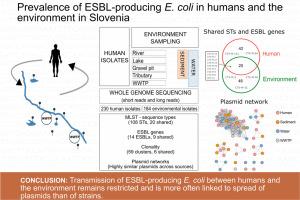人类与斯洛文尼亚东北部环境之间产生esbl的大肠杆菌的克隆性有限,但质粒广泛共享
IF 5.8
Q1 MICROBIOLOGY
引用次数: 0
摘要
产广谱β -内酰胺酶(ESBL)的大肠杆菌是一种重要的抗微生物耐药性病原体。虽然在人类和动物身上得到了充分的研究,但它在环境中的存在仍未得到充分的探索。本研究分析了斯洛文尼亚东北部人类和环境来源的产esbl大肠杆菌的基因型和质粒组成。在一年的时间里,在包括河流、湖泊和污水处理厂(WWTP)入海口在内的10个地点,每两个月采集一次淡水和沉积物样本。在同一时期和同一地理区域收集了人类分离株。采用全基因组测序和生物信息学分析来评估遗传亲缘性、耐药基因和质粒组成。在414株被测序的分离株(230株人源,184株环境源)中,鉴定出108种多位点序列类型(MLST-ST),其中20种多位点序列具有同源性。核心基因组MLST (cgMLST)共发现59个克隆簇,其中6个包括人类和环境分离株。ESBL的优势基因为blaCTX−M-15(占所有ESBL分离株的59%),54%的ESBL分离株在质粒上携带ESBL基因。质粒集群AA474在不同来源、STs和地点发现,与多个ESBL基因相关,表明其在耐药性传播中起关键作用。尽管人类和环境之间共享STs、ESBL基因和质粒,但cgMLST分析显示克隆传播有限。这表明人类与环境之间的传播仍然受到限制,并且更多地与质粒的传播而不是菌株的传播有关。本文章由计算机程序翻译,如有差异,请以英文原文为准。

Limited clonality but widespread plasmid sharing of ESBL-producing E. coli between humans and the environment of northeastern Slovenia
Extended-spectrum beta-lactamase (ESBL)-producing Escherichia coli is a critical antimicrobial-resistant pathogen. While well-studied in humans and animals, its presence in the environment remains underexplored. This study analyses the genotypes and plasmid composition of ESBL-producing E. coli from human and environmental sources in Northeastern Slovenia. Freshwater and sediment samples were collected bimonthly during one year at ten sites, including rivers, lakes, and wastewater treatment plant (WWTP) influents. Human isolates were collected during the same period and geographic area. Whole-genome sequencing and bioinformatic analyses were conducted to evaluate genetic relatedness, antimicrobial resistance genes, and plasmid composition. Among 414 sequenced isolates (230 human, 184 environmental), 108 multilocus sequence types (MLST-ST) were identified, with 20 STs shared between sources. Core-genome MLST (cgMLST) revealed 59 clonal clusters, six of which included both human and environmental isolates. The dominant ESBL gene was blaCTX−M-15 (59 % of all ESBL isolates), and 54 % of all ESBL isolates carried ESBL genes on plasmids. Plasmid cluster AA474, found across different sources, STs, and locations, was linked to multiple ESBL genes, suggesting a key role in resistance dissemination. Despite shared STs, ESBL genes, and plasmids between humans and the environment, cgMLST analysis indicated limited clonal spread. This suggest that transmission between humans and the environment remains restricted and is more often linked to spread of plasmids than of strains.
求助全文
通过发布文献求助,成功后即可免费获取论文全文。
去求助
来源期刊

Current Research in Microbial Sciences
Immunology and Microbiology-Immunology and Microbiology (miscellaneous)
CiteScore
7.90
自引率
0.00%
发文量
81
审稿时长
66 days
 求助内容:
求助内容: 应助结果提醒方式:
应助结果提醒方式:


